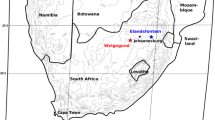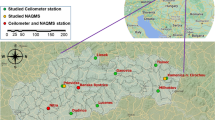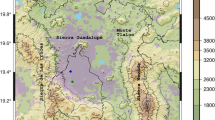Abstract
Accurate measurements of the depth of the convective boundary layer (CBL) are fundamental for understanding and forecasting weather, air quality, and climate. However, the CBL depth (BLD) shows significant spatial and temporal variability, which is challenging to measure and model. Ceilometer instruments, which estimate the CBL depth from aerosol layers, are relatively cheap, have high temporal resolution, and have the potential for increased spatial coverage. Nevertheless, their performance in subtropical environments with low aerosol concentrations is unknown. Furthermore, climatological studies of the variability in the urban CBL depth are scarce, especially in the Southern Hemisphere, and very few studies have examined the relationship between BLD variability and synoptic conditions. Using three years of continuous ceilometer data, we present a novel climatology of the temporal variability in CBL depth over the Southern Hemisphere subtropical, coastal city of Auckland, New Zealand. The results indicate that the median daytime maximum CBL depth (BLDMAX) over the Auckland CBD is 1100 m a.g.l. (above ground level) during summer and 700 m a.g.l. during winter. Strong relationships are found between the maximum CBL depth and both solar radiation and soil moisture; however, no relationship is found between the maximum CBL depth and the synoptic conditions as determined by the New Zealand Kidson weather types synoptic classification. The absence of a relationship between the maximum CBL depth and Kidson weather types may explain the poor correlation previously observed between synoptic class and air pollution events in Auckland.












Similar content being viewed by others
References
Angevine WM, White AB, Senff CJ, Trainer M, Banta RM, Ayoub MA (2003) Urban-rural contrasts in mixing height and cloudiness over Nashville in 1999. J Geophys Res Atmos 108:1–10. https://doi.org/10.1029/2001JD001061
Appelhans T, Sturman A, Zawar-Reza P (2013) Synoptic and climatological controls of particulate matter pollution in a Southern Hemisphere coastal city. Int J Climatol 33:463–479. https://doi.org/10.1002/joc.3439
Bachtiar VS, Davies F, Danson FM (2014) A combined model for improving estimation of atmospheric boundary layer height. Atmos Environ 98:461–473. https://doi.org/10.1016/j.atmosenv.2014.09.028
Baldi M, Salinger J, Dirks K, Mcgregor G (2009) Winter hospital admissions and weather types in the Auckland Region. In: 9th International Conference on Southern Hemisphere Meteorology and Oceanography. 9th International Conference on Southern Hemisphere Meteorology and Oceanography, Melbourne, Australia, Melbourne, Australia, pp 9–13
Banta RM, White AB (2003) Mixing-height differences between land use types: Dependence on wind speed. J Geophys Res Atmos 108:ALC11.1–ALC11.10. https://doi.org/10.1029/2002jd002748
Barlow JF (2014) Progress in observing and modelling the urban boundary layer. Urban Clim 10:216–240. https://doi.org/10.1016/j.uclim.2014.03.011
Barlow JF, Dunbar TM, Nemitz EG, Wood CR, Gallagher MW, Davies F, Connor EO, Harrison RM (2011) Boundary layer dynamics over London, UK, as observed using Doppler lidar during REPARTEE-II. Atmos Chem Phys 11:2111–2125. https://doi.org/10.5194/acp-11-2111-2011
Boamponsem LK, de Freitas CR (2017) Validation of Parmotrema reticulatum as a biomonitor of elemental air pollutants in Auckland, New Zealand. J R Soc New Zeal 47:275–293. https://doi.org/10.1080/03036758.2017.1296472
Brooks IM (2003) Finding boundary layer top: Application of a wavelet covariance transform to lidar backscatter profiles. J Atmos Ocean Technol 20:1092–1105. https://doi.org/10.1175/1520-0426(2003)020%3c1092:FBLTAO%3e2.0.CO;2
Buchanan CM, Beverland IJ, Heal MR (2002) The influence of weather-type and long-range transport on airborne particle concentrations in Edinburgh, UK. Atmos Environ 36:5343–5354. https://doi.org/10.1016/S1352-2310(02)00579-4
Caicedo V, Rappenglück B, Lefer B, Morris G, Toledo D, Delgado R (2017) Comparison of aerosol lidar retrieval methods for boundary layer height detection using ceilometer aerosol backscatter data. Atmos Meas Tech 10:1609–1622. https://doi.org/10.5194/amt-10-1609-2017
Chappell PR (2013) The Climate and Weather of Auckland, 2nd edition. NIWA Science and Technology Series Report No. 60. NIWA, New Zealand
Coen MC, Praz C, Haefele A, Ruffieux D, Kaufmann P, Calpini B (2014) Determination and climatology of the planetary boundary layer height above the Swiss plateau by in situ and remote sensing measurements as well as by the COSMO-2 model. Atmos Chem Phys 14:13205–13221. https://doi.org/10.5194/acp-14-13205-2014
Crespi SN, Artinano B, Cabal H (1995) Synoptic Classification of the Mixed-Layer Height Evolution. J Appl Meteorol 34:1666–1677
Davies F, Middleton DR, Bozier KE (2007) Urban air pollution modelling and measurements of boundary layer height. Atmos Environ 41:4040–4049. https://doi.org/10.1016/j.atmosenv.2007.01.015
Davy PK, Trompetter WJ, Ancelet T, Markwitz A (2017) Source Apportionment and Trend Analysis of Air Particulate Matter in the Auckland Region. Technical Report 2017/001. Institute of Geological and Nuclear Sciences Ltd, GNS Science, Auckland, New Zealand
de Bruine M, Apituley A, Donovan DP, Baltink HK, de Haij MJ (2017) Pathfinder: Applying graph theory to consistent tracking of daytime mixed layer height with backscatter lidar. Atmos Meas Tech 10:1893–1909. https://doi.org/10.5194/amt-10-1893-2017
de Haij M, Wauben W, Klein Baltink H (2006) Determination of mixing layer height from ceilometer backscatter profiles. Remote Sens Clouds Atmos XI 6362:63620R. https://doi.org/10.1117/12.691050
de Haij M, Wauben W, Baltink HK (2007) Continuous mixing layer height determination using the LD-40 ceilometer: a feasibility study. De Bilt, The Netherlands
Emeis S, Schäfer K, Münkel C (2008) Surface-based remote sensing of the mixing-layer height—A review. Meteorol Zeitschrift 17:621–630. https://doi.org/10.1127/0941-2948/2008/0312
Fiddes SL, Pezza AB, Mitchell TA, Kozyniak K, Mills D (2016) Synoptic weather evolution and climate drivers associated with winter air pollution in New Zealand. Atmos Pollut Res 7:1082–1089. https://doi.org/10.1016/j.apr.2016.06.014
Gimson NR (2005) Modelling the air quality of Auckland—A comparison between CALGRID and TAPM simulations based on observed and modelled meteorology. Clean Air Environ Qual 39:38–46
Granados-Munoz MJ, Navas-Guzmán F, Bravo-Aranda JA, Guerrero-Rascado JL, Lyamani H, Fernández-Gálvez J, Alados-Arboledas L (2012) Automatic determination of the planetary boundary layer height using lidar: One-year analysis over southeastern Spain. J Geophys Res 117:1–10. https://doi.org/10.1029/2012JD017524
Griffiths GM, Talbot N, Dirks KN, Betti G, Salmond JA (2019) Forecasting brown haze in Auckland. Weather Clim 39:2–13
Guo J, Miao Y, Zhang Y, Liu H, Li Z, Zhang W, He J, Lou M, Yan Y, Bian L, Zhai P (2016) The climatology of planetary boundary layer height in China derived from radiosonde and reanalysis data. Atmos Chem Phys 16:13309–13319. https://doi.org/10.5194/acp-16-13309-2016
Hägeli P, Steyn DG, Strawbridge KB (2000) Spatial and temporal variability of mixed-layer depth and entrainment zone thickness. Boundary-Layer Meteorol 97:47–71. https://doi.org/10.1023/A:1002790424133
Halios CH, Barlow JF (2018) Observations of the Morning Development of the Urban Boundary Layer Over London, UK, Taken During the ACTUAL Project. Boundary-Layer Meteorol 166:395–422. https://doi.org/10.1007/s10546-017-0300-z
Haman CL, Lefer B, Morris GA (2012) Seasonal variability in the diurnal evolution of the boundary layer in a Near-Coastal Urban environment. J Atmos Ocean Technol 29:697–710. https://doi.org/10.1175/JTECH-D-11-00114.1
Helmis CG, Sgouros G, Flocas H, Schäfer K, Jahn C, Hoffmann M, Heyder C, Kurtenbach R, Niedojadlo A, Wiesen P, O’Connor M, Anamaterou E (2011) The role of meteorology on the background air quality at the Athens International Airport. Atmos Environ 45:5561–5571. https://doi.org/10.1016/j.atmosenv.2011.04.058
Herrera-Mejía L, Hoyos CD (2019) Characterization of the atmospheric boundary layer in a narrow tropical valley using remote-sensing and radiosonde observations and the WRF model: the Aburrá Valley case-study. Q J R Meteorol Soc 145:2641–2665. https://doi.org/10.1002/qj.3583
Holzworth GC (1964) Estimates of Mean Maximum Mixing Depths in the Contiguous United States. Mon Weather Rev 92:235–242. https://doi.org/10.1175/1520-0493(1964)092%3c0235:EOMMMD%3e2.3.CO;2
Holzworth GC (1967) Mixing depths, wind speeds and air pollution potential for selected locations in the United States. J Appl Meteorol 6:1039–1044
Hu XM, Ma ZQ, Lin W, Zhang H, Hu J, Wang Y, Xu X, Fuentes JD, Xue M (2014) Impact of the Loess Plateau on the atmospheric boundary layer structure and air quality in the North China Plain: A case study. Sci Total Environ 499:228–237. https://doi.org/10.1016/j.scitotenv.2014.08.053
Jiang N, Griffiths G, Dirks KN (2011) Linking synoptic weather types to daily rainfall in Auckland. Weather Clim 31:50–66. https://doi.org/10.2307/26169717
Jiang N, Dirks KN, Luo K (2014) Effects of local, synoptic and large-scale climate conditions on daily nitrogen dioxide concentrations in Auckland, New Zealand. Int J Climatol 34:1883–1897. https://doi.org/10.1002/joc.3808
Kallos G, Kassomenos P, Pielke RA (1993) Synoptic and mesoscale weather conditions during air pollution episodes in Athens, Greece. Boundary-Layer Meteorol 62:163–184. https://doi.org/10.1007/BF00705553
Khan BA (2010) Sea Breeze Circulation in the Auckland Region: Observational Data Analysis and Numerical Modelling. Dissertation, University of Canterbury, Christchurch, New Zealand
Khan BA, de Freitas CR, Shooter D (2007) Application of synoptic weather typing to an investigation of nocturnal ozone concentration at a maritime location, New Zealand. Atmos Environ 41:5636–5646. https://doi.org/10.1016/j.atmosenv.2007.02.040
Kidson JW (2000) An Analysis of New Zealand Synoptic Types and Their Use in Defining Weather Regeimes. Int J Climatol 20:299–316. https://doi.org/10.1016/j.chemosphere.2008.10.024
Kotthaus S, Grimmond CSB (2018a) Atmospheric boundary-layer characteristics from ceilometer measurements. Part 1: A new method to track mixed layer height and classify clouds. Q J R Meteorol Soc 144:1525–1538. https://doi.org/10.1002/qj.3299
Kotthaus S, Grimmond CSB (2018b) Atmospheric boundary-layer characteristics from ceilometer measurements. Part 2: Application to London’s urban boundary layer. Q J R Meteorol Soc 144:1511–1524. https://doi.org/10.1002/qj.3298
Leighton RM, Spark E (1997) Relationship between synoptic climatology and pollution events in Sydney. Int J Biometeorol 41:76–89. https://doi.org/10.1007/s004840050057
Li H, Yang Y, Hu XM, Huang Z, Wang G, Zhang B (2017) Application of convective condensation level limiter in convective boundary layer height retrieval based on lidar data. Atmosphere (Basel) 8:1–16. https://doi.org/10.3390/atmos8040079
Li K, Zhang J, Wu L (2018) Assessment of Soil Moisture-Temperature Feedbacks With the CCSM-WRF Model System Over East Asia. J Geophys Res Atmos 123:6822–6839. https://doi.org/10.1029/2017JD028202
LINZ Data Service (2014) NZ Coastlines and Islands Polygons (Topo 1:500 k). https://data.linz.govt.nz/layer/51560-nz-coastlines-and-islands-polygons-topo-1500k/. Accessed 10 Sep 2019
LINZ Data Service (2018) NZ 10 m Satellite Imagery (2017). https://data.linz.govt.nz/layer/93652-nz-10m-satellite-imagery-2017/. Accessed 10 Sep 2019
Liu S, Liang XZ (2010) Observed diurnal cycle climatology of planetary boundary layer height. J Clim 23:5790–5809. https://doi.org/10.1175/2010JCLI3552.1
Ma M, Pu Z, Wang S, Zhang Q (2011) Characteristics and Numerical Simulations of Extremely Large Atmospheric Boundary-layer Heights over an Arid Region in North-west China. Boundary-Layer Meteorol 140:163–176. https://doi.org/10.1007/s10546-011-9608-2
McGill AJ (1987) Sea Breeze Circulations About Auckland. New Zealand Meteorological Service, Wellington, New Zealand
McKendry IG (1989) Numerical simulation of sea breezes over the Auckland Region, New Zealand - Air quality implications. Boundary-Layer Meteorol 49:7–22
McKenzie RL, Bodeker GE, Keep DJ, Kotkamp M (1996) UV Radiation in New Zealand: North-to-South Differences Between Two Sites, and Relationship to Other Latitudes. Weather Clim 16:17–26. https://doi.org/10.2307/44279891
Miao Y, Guo J, Liu S, Liu H, Li Z, Zhang W, Zhai P (2017) Classification of summertime synoptic patterns in Beijing and their associations with boundary layer structure affecting aerosol pollution. Atmos Chem Phys 17:3097–3110. https://doi.org/10.5194/acp-17-3097-2017
Miao Y, Liu S, Huang S (2019) Synoptic pattern and planetary boundary layer structure associated with aerosol pollution during winter in Beijing, China. Sci Total Environ 682:464–474. https://doi.org/10.1016/j.scitotenv.2019.05.199
Nilsson ED, Rannik Ü, Kumala M, Buzorius G, O’dowd CD, Rannik Ü, Kumala M, Buzorius G, O’Dowd CD (2001) Effects of continental boundary layer evolution, convection, turbulence and entrainment, on aerosol formation. Tellus B Chem Phys Meteorol 53B:441–461. https://doi.org/10.3402/tellusb.v53i4.16617
Pal S (2014) Monitoring depth of shallow atmospheric boundary layer to complement LiDAR measurements affected by partial overlap. Remote Sens 6:8468–8493. https://doi.org/10.3390/rs6098468
Pal S, Haeffelin M (2015) Forcing mechanisms governing diurnal, seasonal, and interannual variability in the boundary layer depths: Five years of continuous lidar observations over a suburban site near Paris. J Geophys Res Atmos 120:11936–11956. https://doi.org/10.1002/2015JD023268
Pal S, Lee TR (2019) Contrasting Air Mass Advection Explains Significant Differences in Boundary Layer Depth Seasonal Cycles Under Onshore Versus Offshore Flows. Geophys Res Lett 46:2846–2853. https://doi.org/10.1029/2018GL081699
Pal S, Behrendt A, Wulfmeyer V (2010) Elastic-backscatter-lidar-based characterization of the convective boundary layer and investigation of related statistics. Ann Geophys 28:825–847. https://doi.org/10.5194/angeo-28-825-2010
Pal S, Xueref-Rémy I, Ammoura L, Chazette P, Gilbert F, Royer P, Dieudonné E, Dupont J-C, Haeffelin M, Lac C, Lopez M, Morille Y, Ravetta F (2012) Spatio-temporal variability of the atmospheric boundary layer depth over the Paris agglomeration: An assessment of the impact of the urban heat island intensity. Atmos Environ 63:261–275. https://doi.org/10.1016/j.atmosenv.2012.09.046
Parsons S, McDonald AJ, Renwick JA (2014) The use of synoptic climatology with general circulation model output over New Zealand. Int J Climatol 34:3426–3439. https://doi.org/10.1002/joc.3919
Peng J, Grimmond CSB, Fu X, Chang Y, Zhang G, Guo J, Tang C, Gao J, Xu X, Tan J (2017) Ceilometer-based analysis of Shanghai’s boundary layer height (under rain- and fog-free conditions). J Atmos Ocean Technol 34:749–764. https://doi.org/10.1175/JTECH-D-16-0132.1
Quan J, Gao Y, Zhang Q, Tie X, Cao J, Han S, Meng J, Chen P, Zhao D (2013) Evolution of planetary boundary layer under different weather conditions, and its impact on aerosol concentrations. Particuology 11:34–40. https://doi.org/10.1016/j.partic.2012.04.005
Salmond JA, Dirks KN, Fiddes S, Pezza A, Talbot N, Scarfe J, Renwick J, Petersen J (2016) A climatological analysis of the incidence of brown haze in Auckland, New Zealand. Int J Climatol 36:2516–2526. https://doi.org/10.1002/joc.4509
Schween JH, Hirsikko A, Löhnert U, Crewell S (2014) Mixing-layer height retrieval with ceilometer and Doppler lidar: From case studies to long-term assessment. Atmos Meas Tech 7:3685–3704. https://doi.org/10.5194/amt-7-3685-2014
Seibert P, Beyrich F, Gryning S-E, Joffre S, Rasmussen A, Tercier P (2000) Review and intercomparison of operational methods for the determination of the mixing height. Atmos Environ 34:1001–1027. https://doi.org/10.1016/S1352-2310(99)00349-0
Sicard M, Perez C, Rocadenbosch F, Baldasano JM, García-Vizcaino D (2006) Mixed-layer depth determination in the Barcelona coastal area from regular lidar measurements: Methods, results and limitations. Boundary-Layer Meteorol 119:135–157. https://doi.org/10.1007/s10546-005-9005-9
Statistics New Zealand (2019) 2018 Census population and dwelling counts. https://www.stats.govt.nz/information-releases/2018-census-population-and-dwelling-counts. Accessed 8 Oct 2019
Stull RB (1988) An introduction to boundary layer meteorology. Kluwer Academic Publishers, Dordrecht, The Netherlands
Tang G, Zhang J, Zhu X, Song T, Münkel C, Hu B, Schäfer K, Liu Z, Zhang J, Wang L, Xin J, Suppan P, Wang Y (2016) Mixing layer height and its implications for air pollution over Beijing, China. Atmos Chem Phys 16:2459–2475. https://doi.org/10.5194/acp-16-2459-2016
van der Kamp D, McKendry I (2010) Diurnal and Seasonal Trends in Convective Mixed-Layer Heights Estimated from Two Years of Continuous Ceilometer Observations in Vancouver, BC. Boundary-Layer Meteorol 137:459–475. https://doi.org/10.1007/s10546-010-9535-7
van Heerwaarden CC, Vila-Guerau de Arellano J, Moene AF, Holtslag AAM (2009) Interactions between dry-air entrainment, surface evaporation and convective boundary-layer development. Q J R Meteorol Soc 135:1277–1291. https://doi.org/10.1002/qj.431
Wagner P, Schäfer K (2017) Influence of mixing layer height on air pollutant concentrations in an urban street canyon. Urban Clim 22:64–79. https://doi.org/10.1016/j.uclim.2015.11.001
Wai KM, Tanner PA (2005) Extreme particulate levels at a Western Pacific Coastal City: The influence of meteorological factors and the contribution of long-range transport. J Atmos Chem 50:103–120. https://doi.org/10.1007/s10874-005-5897-5
White JM, Bowers JF, Hanna SR, Lundquist JK (2009) Importance of using observations of mixing depths in order to avoid large prediction errors by a transport and dispersion model. J Atmos Ocean Technol 26:22–32. https://doi.org/10.1175/2008JTECHA1134.1
Wiegner M, Madonna F, Binietoglou I, Forkel R, Gasteiger J, Geiß A, Pappalardo G, Schäfer K, Thomas W (2014) What is the benefit of ceilometers for aerosol remote sensing? An answer from EARLINET. Atmos Meas Tech 7:1979–1997. https://doi.org/10.5194/amt-7-1979-2014
Yang D, Li C, Lau AKH, Li Y (2013) Long-term measurement of daytime atmospheric mixing layer height over Hong Kong. J Geophys Res Atmos 118:2422–2433. https://doi.org/10.1002/jgrd.50251
Zhu X, Tang G, Guo J, Hu B, Song T, Wang L, Xin J, Gao W, Münkel C, Schäfer K, Li X, Wang Y (2018) Mixing layer height on the North China Plain and meteorological evidence of serious air pollution in southern Hebei. Atmos Chem Phys 18:4897–4910. https://doi.org/10.5194/acp-18-4897-2018
Acknowledgements
The authors wish to thank David Dicker, Reijo Roininen, and Christoph Münkel at Väisälä for their help in our use of BL-VIEW and its application to ceilometer data collected under an older data format. We would like to thank Dr. Andrew Neverman for his advice on multiple regression analysis and soil moisture, and for his help with R and QGIS. We wish to thank Dr. Arier Lee for her statistics advice and Dr. Anthony Fowler for his advice on the use of the soil moisture data. We would also like to thank two anonymous reviewers for their helpful and thorough reviews of the manuscript which greatly contributed to the clarification and scope of the paper. The authors declare that they have no conflict of interest.
Author information
Authors and Affiliations
Corresponding author
Additional information
Publisher's Note
Springer Nature remains neutral with regard to jurisdictional claims in published maps and institutional affiliations.
Rights and permissions
About this article
Cite this article
Marley, H.G., Dirks, K.N., McKendry, I. et al. A Ceilometer-Derived Climatology of the Convective Boundary Layer Over a Southern Hemisphere Subtropical City. Boundary-Layer Meteorol 178, 435–462 (2021). https://doi.org/10.1007/s10546-020-00579-w
Received:
Accepted:
Published:
Issue Date:
DOI: https://doi.org/10.1007/s10546-020-00579-w




